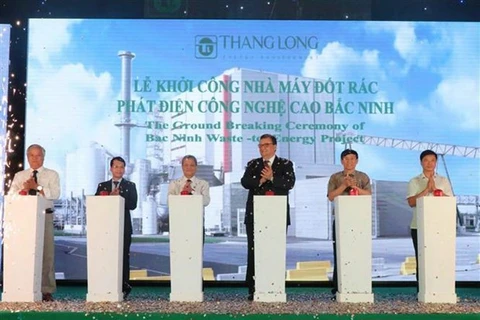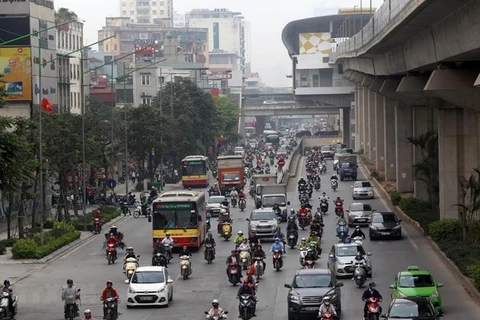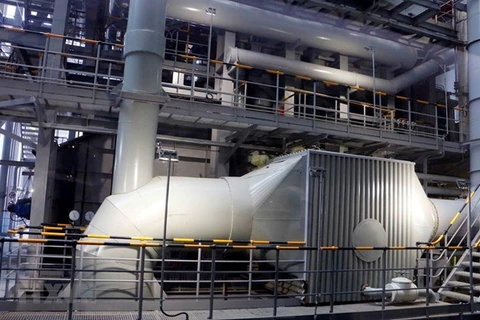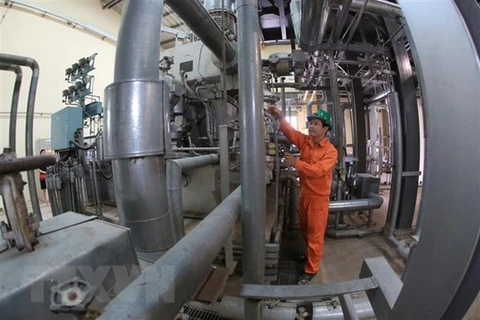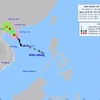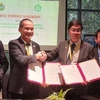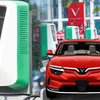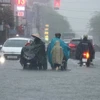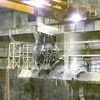 A power generation factory using industrial waste in Hanoi’s outlying district of Soc Son (Photo: VNA)
A power generation factory using industrial waste in Hanoi’s outlying district of Soc Son (Photo: VNA)
Hanoi (VNA) - About 50,000 tonnes of waste are dumped into the environment every day, about 35,000 tonnes of which are dumped into urban areas. In order to address such a large volume of waste, it is necessary to issue priority policies on waste-to-power technology.
At an online seminar held on July 24 featuring investment opportunities on waste treatment and recycling in Vietnam, urban environment experts said waste-fueled electricity needs to be given the top priority at present as many landfills that have become overloading, putting pressure on the environment.
However, the incineration of waste to generate electricity has also met difficulties due to the high cost of technology, while the efficiency is low due to unclassified waste and those with high humidity. Therefore, it is necessary to have incentives as well as synchronous measures from the Government, localities and investors.
Urban waste forecast to continue rising
Prof. Dr. Nguyen Van Lien, former Deputy Minister of Construction and Chairman of the Vietnam Urban Environment and Industrial Zone Association, said waste is a big issue that seriously impacts the living environment unless it is thoroughly dealt with, especially in urban areas.
Statistics showed that around 50,000 tonnes of waste are dumped into the environment each day, of which nearly 35,000 tonnes are dumped in urban areas and the remaining in rural areas. In Hanoi and Ho Chi Minh City alone, there are 7,000 – 8,000 tonnes of waste each day, over 80 percent of them are treated by landfill technology.
Investment in treatment technology to recycle domestic solid waste is an issue that should be treated with priority, Lien said.
Sharing the same view, Prof. Dr. Nguyen Huu Dung, Director of the Vietnam Institute of Urban Environment and Industry, said Vietnam is facing considerable challenges in treating waste because the volume of waste increases by 10-12 percent annually.
Statistics showed that Vietnam now has about 858 urban areas with an urbanisation rate of 39.3 percent. The total volume of solid waste reaches about 15 million tonnes each year, including nearly 34,500 tonnes of urban domestic waste and more than 14,000 tonnes of rural waste per day, but collection rate is only 40-45 percent.
“It is worth noting that, given the current situation, rural waste will decrease due to urbanisation. Therefore, urban waste will increase”, Dung forecast, adding that waste collection and transportation have improved, but investment in technology still faces difficulties.
Incentives are needed
Prof. Dung highlighted the need to look toward waste treatment technology transformation. He said waste-to-power technology has many advantages that could meet environmental protection requirements.
He added that incineration technology used for solid waste treatment in Vietnam should be carefully considered under the following conditions: Is there enough waste to run an incinerator continuously? Without enough waste, incinerator maintenance cost is very high while revenue from energy production is low.
The second is the exothermic capacity of waste. Is there any measure to prove that urban solid waste will generate more electricity than that used in an incinerator? As the problem of waste treatment is high humidity and organic waste volume, there should be garbage pressing and classification technology.
With a cost of at least 40 million USD to burn 300,000 tonnes of waste per year, is it affordable to localities?
From the above concerns, Dung suggested that the State and localities should issue incentives to ensure waste electricity prices.
General Director of the Hanoi Urban Environment Co. Ltd Nguyen Huu Tien said Hanoi is currently divided into three regions which already have regulations on the planning of waste management areas from now until 2030 with a vision to 2050.
Based on such planning, Hanoi is carrying out waste treatment projects, particularly the Nam Son waste treatment area in the outlying district of Soc Son. Up to 5,000 -5,500 tonnes of domestic waste is collected per day with a capacity of 4,000 tonnes per day. The plant is expected to be put into operation in late 2021 to early 2022.
Several waste incineration projects are also underway, including Xuan Son waste-to-power plant with a daily capacity of 1,000 tonnes, which is expected to operate in August due to slow progress; the Xuan Son – Son Tay waste-fueled factory project with a daily capacity of 1,500 tonnes, and Dong Ke waste-to-power project with a daily capacity of 1,200 tonnes./.

